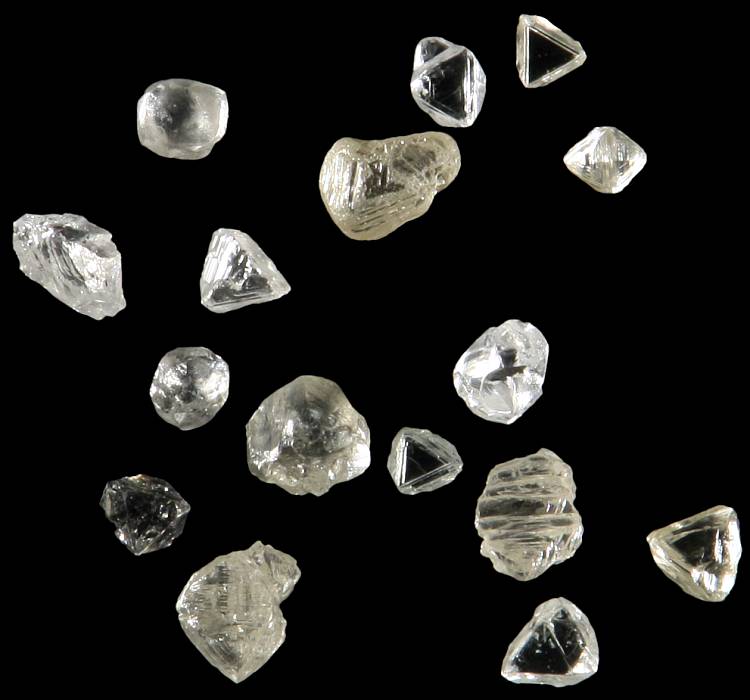Diamond is one of the most well known minerals although it is very rare. Perhaps this is the reason it is so well known? However, there are hundreds of exceedingly rare minerals that are virtually unknown, even for mineralogists. There has to be more good reasons to explain the fame of diamond.

Diamond crystals from the Democratic Republic of Congo. Width of view 4 mm.
Diamond is known for its extreme properties which mostly originate from the strong covalent bonding between the atoms forming the crystal lattice of diamond. These are all carbon atoms (almost), each one of them forming covalent bonds with four other carbon atoms. Hence, the chemical formula of diamond is very simple — C.
The extreme hardness is the most important reason diamond is important and extensively used industrial mineral. Most industrially used diamonds are artificial. The hardness of diamond seems to be universally known property but much less known is the fact that diamond also has very high thermal conductivity (highest of any material).
Another important property of diamond is its high optical dispersion. It means that light that penetrates diamond is split into components with different wavelengths. This is what gives “fire” to diamond (flashes of differently colored light).
Diamond is usually almost pure but 58 other elements have been found. These are mostly impurities outside the crystal lattice. Only two chemical elements, nitrogen and boron, can replace carbon in the lattice.
Natural diamonds form in the mantle at depths of approximately 150…200 km. Temperature range there in 900…1200 °C. It can not form in the crust because there are not enough pressure. Rare exceptions are impact events which create very high pressure for a very short time and may therefore result in the formation of many microscopic diamond crystals. The formation conditions of diamond are very different from the atmospheric conditions to which they are exposed at the surface. It should normally result in low resistance to weathering but diamond tolerates weathering very well because of its strong covalent bonds.
Diamonds are mostly found in ultramafic rocks named kimberlites and lamproites. It is usually kimberlite that hosts diamonds but the most productive diamond mine is Argyle in Australia where about 7,000 kg of diamonds a year is produced. These diamonds are extracted from lamproites. Kimberlite is a volcanic breccia that fills diatremes (pipe-like volcanic vents) that are formed by gas-charged explosions which transport kimberlitic material (and diamonds within it) from great depths up to the surface.
Most important diamond producing countries are South Africa (plus more countries in Southern Africa), Australia, Russia, Canada, Brazil, India, China, etc. Diamond-bearing rocks have been found on every continent except Antarctica. There is no reason to think that Antarctica does not have diamonds but we simply can not look below the thick ice shield and it would not make much sense economically because mining in Antarctica is currently not allowed anyway.
Diamond occurs as a detrital mineral but its concentration in sand is always very low. However, diamond-bearing kimberlite pipes are often found by working through many fluvial sand samples but it is not diamond that prospectors are looking for. These are mostly dark red Mg-rich garnet pyrope and bright green chromian diopside which occur in kimberlite in much higher concentration than diamond and they are also visually easier to spot in sand samples.
Just to add, only around 20% of the diamonds mined are of gem quality (that can be used in jewelry). Rest 80% are used for industrial purpose.